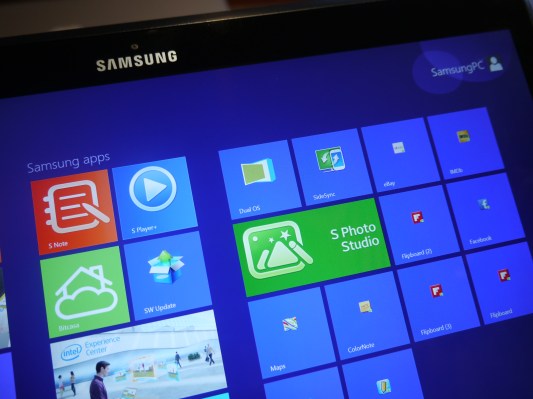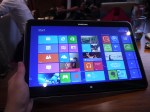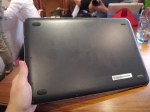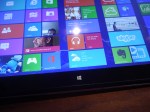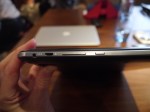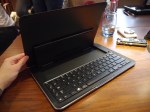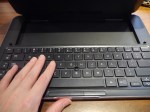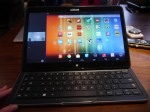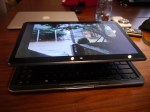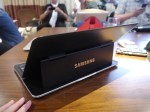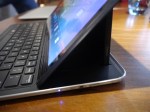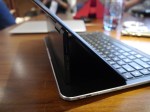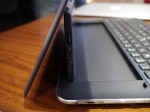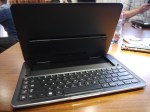Samsung just pulled back the curtain on a new line of Ativ Windows notebooks, but perhaps the most interesting of the company’s new Ativs is a 13.3-inch convertible tablet it hopes will appeal those prepping to head back to school. The shape-shifting Ativ Q sports a tablet mode, a video-friendly formfactor with the screen held near vertical, and a more traditional notebook configuration that reveals its built-in QWERTY keyboard, but it’s got an even niftier trick up its sleeve.
While the Ativ Q boots into Windows 8 there’s also a dual-OS mode that allows the users to switch to stock Android 4.2.2, thereby allowing for Microsoft productivity staples such as Office to live in close proximity to the Google Play Store and the usual gamut of Android apps. It’s a cake-and-eat-it-too tablet. Or a tablet for someone who just can’t decide between Windows or Android.
The Ativ Q also supports the classic Windows desktop mode – and since the tablet includes Samsung’s S Pen stylus (which pulls out from a slot in its side) the tiny menus of classic Windows aren’t as fiddly as they would otherwise be to navigate on such a device.
Samsung said photos and files can be shared between the Windows and Android OS modes. Switching between the different OSes seemed fast during my brief hands on, although it’s relatively easy to accidentally revert to Windows. The Ativ Q is not a native Android device, being as it’s not booting directly to Android, but Samsung made a point of demoing a handful of Android games, including Angry Birds, running on the Ativ Q to show it is capable of handling such apps without a significant dip in performance.
The touchscreen display is QHD with a resolution of 3,200 x 1,800, which works out to a pixel density of about 275 PPI. The aspect ratio of the screen means the device feels quite long and narrow (not unlike plenty of other Windows convertibles). The entire device also feels very hefty – it’s not a tablet you want to hold in your hands for long — and it’s relatively thick, at 13.9mm wide. It is a serious bit of kit to lug about, but if you consider it as a laptop replacement rather than an iPad competitor then that’s perhaps to be expected. It’s certainly not the world’s most elegant slice of portable computing but Samsung is obviously hoping its flexibility is what will make it stand out.
Pulling up on the side of the screen when the device is in tablet mode lifts it out on a built-in hinged stand so it can be angled in a variety of ways, including a so-called “floating” mode suitable for presentations when a standing speaker needs to look down at the screen. The display can also be angled steeply up, with the keyboard entirely out of sight, to view videos. And it can be moved into a typing mode where the display is tucked behind the built-in keyboard.
This keyboard felt unpleasantly plasticky to my fingertips but it was relatively roomy, despite taking up less than half the width of the device. There’s no space for a trackpad but Samsung has added in an optical nav key in the centre of the keyboard if you prefer not to use the touchscreen, plus three physical selection keys at the edge of the keyboard to act as mouse keys.
Samsung has sited the device’s CPU and components inside the flexible stand portion of the device, rather than inside the screen or under the keyboard. It said it wanted to keep the hot parts away from the bits the user touches. Whether that’s a huge advantage remains to be seen, but it does mean the screen is thinner than it might have been otherwise, so probably a little easier to move around.
The screen has a Windows touch-key on the front which returns the user to the Windows 8 homescreen, There’s a tile on that interface for switching to the Android OS (and another for Windows Classic). When using the device in the Android scenario, there are additional nav keys along the bottom of the screen for switching back to Windows. The device being demoed during my hands on was running stock Android 4.2.2, rather than having any TouchWiz overlay.
Samsung said pricing for the Ativ Q will be confirmed later, and the price tag is likely going to be the deciding factor on whether this hybrid beast flies. It’s not what you’d call stylish or elegant, and its weight puts its portability in doubt, but it has the potential to be a bit of a workhorse -– with both Windows and Android, and tablet and QWERTY functionality on tap.
